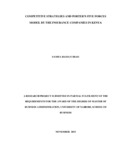| dc.description.abstract | The state of competition in an industry depends on five basic forces. Porter’s five forces
model is an analysis tool that uses five forces to determine the profitability of an industry
and shape a firm’s competitive strategy. It is a framework that classifies and analyses the
most important forces affecting the intensity of competition in an industry and its
profitability level (Porter, 2008). Five forces model is very useful in formulating firm’s
strategy as it reveals how powerful each of the five key forces is in a particular industry
(Porter, 2008).Low insurance penetration is one of the challenges facing the insurance
industry development in terms of market share, product diversification among other
measures. The essence of competitive strategies is coping with competition. This study
sought to fill the existing research gap by investigating on the challenges facing insurance
companies in building competitive advantage in Kenya. The survey research design
method was employed in this research. The survey is a method for collecting information
or data as reported by individuals. The population for this study was 47 insurance
companies in Kenya which operate under an umbrella body, the Association of Kenya
Insurers (AKI) and regulated by the Insurance Regulatory Authority (IRA). The study
was done using survey method to conduct the research. Self-administered questionnaires
were used to collect primary data. The study generated both qualitative and quantitative
data. Descriptive statistics data analysis method was applied to analyze both quantitative
and qualitative data. Descriptive statistics helped to compute measures of central
tendencies and measures of variability (Bell, 2007).Qualitative data was analyzed using
content analysis. The analyzed findings were then presented inform of frequency tables,
pie charts and bar charts since they are user friendly and gave a graphical representation
of the different responses given by the respondents. The study concludes that the
insurance companies in Kenya do apply the Porter’s five forces model in establishing
competitive strategies to a great extent. The study further concludes that then companies
apply the threat of entry force to determine the competitive strategy to adopt in order to
discourage entry of new companies into the industry. The powerful supply force has
enabled the companies to provide their customers with services at a relatively higher
price. Further conclusions can be drawn that insurance companies that apply the threat of
substitutes force are able to find about substitute products that pose competition which in
turn enables them know which competitive strategy to adopt. The study recommends that
companies need to be keen when applying the force of bargaining power of the supplier,
since suppliers have strong bargaining power only when there are few suppliers but many
buyers. There is need for the insurance companies to differentiate their services so as to
stand out from the crowd. This way, the companies will be able to offer unique services
that are not being offered by their competitors and will be in a position to retain their
customers. The study recommends that insurance companies should adopt the cost
leadership strategy due to the fact it is associated with internal strengths such as access to the capital required to make a significant investment in production of their services, since this always presents a barrier to entry that many firms may not overcome. | en_US |

